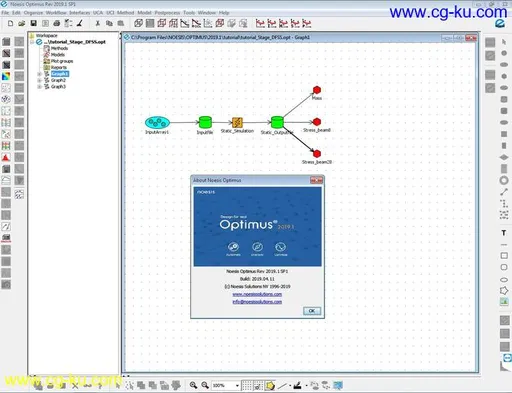OPTIMUS是比利时Noesis Solutions公司的著名集成优化产品。 Noesis Solutions公司作为专业的CAE流程集成和设计优化的公司具有10年以上的CAE和优化的工程经验和深厚的技术积累,使其不仅成为软件产品的供应商,也为用户解决其多学科集成和优化设计问题提供宝贵的专业知识和经验。公司多年来对新方法、新技术持之以恒的投入和开发,使得OPTIMUS多年来始终在同类产品中处于领先位置,受到用户的接受和肯定,目前在汽车、航空航天、船舶、电子、新能源、机械、重工、医疗和电器等多个行业广泛应用。
作为多学科的仿真集成平台,OPTIMUS能够集成并自动化用户的多学科仿真分析流程,实现设计-修改-再分析自动化,能应用现代设计方法(包括试验设计、敏感度分析、响应面建模、参数优化、参数识别、可靠性设计、鲁棒性设计)实现综合优化和自动化分析。软件涉及的学科包括几何造型、结构分析、计算流体力学、控制、动力学、冲击碰撞、震动噪声和疲劳等领域。要求能够集成这些学科所涉及到的CAD/CAE商用软件、以及用户自开发的(基于C/C++、Visual Basic、Fortran、Java、以及其他编程语言)的程序代码。
Noesis Optimus 2019.1 SP1 | 1.7 Gb
Noesis Solutions, the developer of Optimus and id8, announces the release of Optimus Rev. 2019.1. This release enriches Optimus’ range of modeling methods powered by Machine Learning, introducing state-of-the-art Ensemble Modeling and Deep Neural Network Modeling.
Along with significant updates to several interfaces with leading CAD/CAE solutions and a more fine-grained control on engineering workflow execution, this new 2019.1 release brings Optimus’ market-leading PIDO technology to a growing community of both expert and non-expert users.
Deep Neural Network Modeling for high-dimensional engineering problems
Building a bridge between the accuracy of Interpolation modeling and the computational speed of Approximation modeling, Optimus 2019.1 Deep Neural Network modeling is a perfect fit for high-dimensional engineering problems involving large and noisy data sets.
Optimus Deep Neural Networks’ capability to reproduce the behavior of complex, non-linear systems with almost arbitrary accuracy enables a wide range of applications. These include, for example, a much more efficient integration of computationally expensive component models into system simulation models by replacing these component models with high-fidelity Functional Mock-up Units (FMUs). Other potential applications include the analysis of complex CFD images to locate specific features such as turbulence or the evaluation of a high number of different designs while discriminating between feasible and infeasible designs.
Assisting non-expert users through Ensemble Modeling
The Optimus 2019.1 Ensemble Modeling capability is highly recommended for engineering problems that involve relatively small and heterogeneous data sets, and require further engineering expertise to be built up.
Even though Ensemble Modeling belongs to the same model family as the Best Model approach introduced with Optimus 2018.1, both model types are fundamentally different. Whereas the Best Model type selects the best model among the available Optimus models to fit a given data set based on user criteria, Ensemble Modeling creates an entirely new model by averaging the available Optimus models. Ensemble Modeling is particularly useful in assisting non-expert users to better understand their engineering problems via a model averaging approach.
A more fine-grained control on engineering workflow execution
In addition to the new Deep Neural Network & Ensemble Modeling capabilities, Optimus 2019.1 brings significant updates to several interfaces with leading CAD/CAE solutions – including JMAG Designer, PTC Creo 5.0, CETOL 10.2, NX CAE and LS-Dyna. Moreover, Optimus users now have more control on rejection rules when building engineering simulation workflows. Rejection rules are used to determine whether an engineering simulation experiment should be excluded from post-processing, and the related new capabilities grant a more fine-grained control on engineering workflow execution.
Product:
Noesis Optimus
Version:
2019.1 SP1 build 2019.04.11
Supported Architectures:
x64
Language:
english
System Requirements:
PC / Linux
Supported Operating Systems:
Cross-platform
Size:
1.7 Gb


发布日期: 2019-06-29